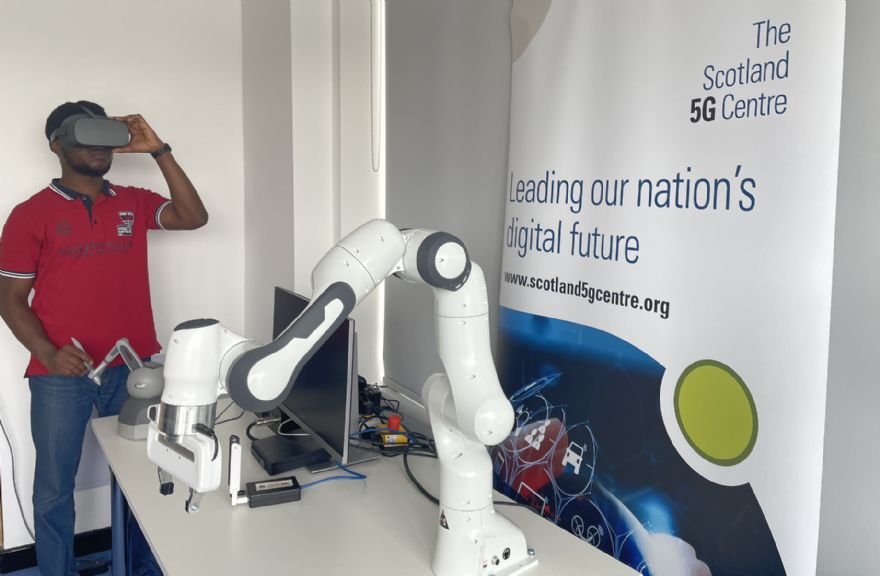
A testbed mobile network, developed at the
University of Glasgow, with £1.6 million support from the
Scotland 5G Centre, is creating a new ‘super-immersive’ learning experience which is attracting worldwide attention as a ‘game-changer for the industry’.
A pioneering robotic arm which can be used remotely, allows for an immersive learning experience for students worldwide and provides a blueprint to develop new commercial opportunities.
Students studying, regardless of their location, can work on electronic circuits and experimental set-ups virtually and alongside the lecturer and other students. It allows for multiple students to have a practical experience simultaneously and feel physically present.
The tele-operational, 5G robotic arm uses a haptic feedback controller that allows the students to feel senses of touch, motion and pressure and it is being adapted for other commercial applications where ‘extended’ reality could be beneficial — all in real time.
This new technology is also suitable to provide remote access to specialist centres like the James Watt Nanofabrication Centre. This £35 million ‘state of the art’ centre offers research and international collaboration in nanofabrication technologies used extensively for research and industrial prototyping, such as fabrication of extremely small-size nanoscale devices for the electronics industry.
It is a cleanroom that requires limited and specialised access, and several measures have to be taken before people can enter. However, the robotic arm now allows virtual access for many and opens the experience and opportunities, enabling people to work remotely and in real time, regardless of their location.
Immersive tele-presence experienceThe University of Glasgow and British Telecom have already demonstrated to the First Minister of Scotland, Nicola Sturgeon, how training in such specialised facilities can be carried out using augmented/virtual reality (AR/VR) technology that provides immersive tele-presence experience to remote learners.
Other commercial applications that are currently being researched using this new technology include examining how we learn to drive and take a driving test. The data-transfer speed created using 5G technology provides a real time experience and the technology can allow hazard perception tests without being in a car which could support learner drivers’ experience and reduce waiting lists for lessons and tests.
Enabling partners to test and develop ideas and use cases is how the Scotland 5G Centre is accelerating the adoption of digital technology in Scotland.
Paul Coffey, chief executive of the Scotland 5G Centre, said: “The test bed built at the University of Glasgow is creating a major step change in ideas and adoption of 5G technology. The ability for students to be able to take part in complex work from another country is exciting and beneficial for the learner and the academic partner. Giving remote access to world leading facilities to a larger number of people worldwide is hugely beneficial.
“We are able to create multiple use cases which generates an ecosystem for 5G and leads to further applications across manufacturing, healthcare and the education sectors. The market for remote solutions in the robotic market alone is predicted to be worth $16.8 million by 2023 — the potential for use of 5G across multiple sectors is of enormous economic benefit.”
Professor Muhammad Imran, who leads the research team at the University of Glasgow, said:
“The potential for 5G is remarkable and we have attracted interest from universities in the USA, China, the Far East and the Middle East. The higher quality of user experience offered by 5G connectivity enables us to offer specialised training without students entering the physical space. This has been particularly beneficial during the pandemic and coping with the restriction of movement.
“The investment in super immersive technology combined with almost instantaneous connections provided by 5G allows us to open up to the world the learning experience available from specialist centres like the James Watt Nanofabrication Centre. It also creates dynamic virtual environments for our Electronics and Electrical engineering students, several of whom are learning remotely from our Glasgow College UESTC in Chengdu in China.”
The Scotland 5G centre is currently rolling out its S5GConnect Programme and opening regional hubs in Alloa, Dundee and Dumfries to support economic growth through the deployment and adoption of 5G services across the country in rural and city settings. This programme is supported by a £4 million investment from the Scottish government.